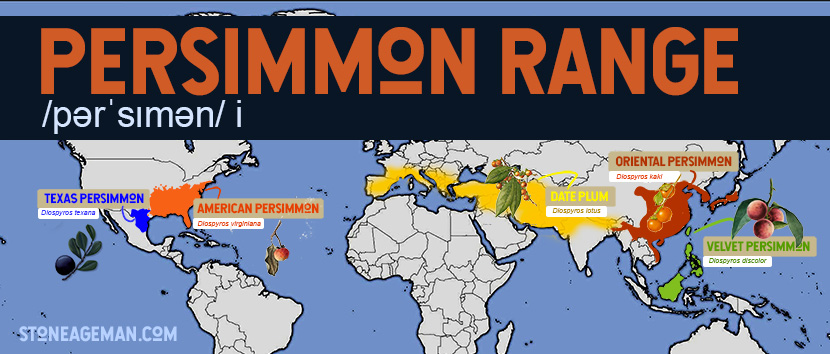Persimmons are delicious! And deadly?!

Understanding persimmons: types, health benefits, dangers, and more!
Maybe you have heard the old legend about persimmons and milk killing you, and though that isn’t quite true, persimmons themselves really can be deadly, however, they can also make for a delicious snack! So, are persimmons dangerous or are persimmons good for you?

What is a persimmon?
First things first we should look at what a persimmon is. Permissions are berries (that’s right, berries!) that grow on trees, the persimmon color is beautiful, and reminds many of us of fall, ranging from bright oranges to deeper reds. There are actually a few different types of permissions around the world, though all of them are from the genus Diospyros. You can find 5 types:
- Texas Persimmon (D. texana)
- American Persimmon (D. viginiana)
- Date Plum (D. lotus)
- Oriental Persimmon (D. kaki)
- Velvet Persimmon (D. discolor)

If you buy persimmons in the store, they are most likely one of these 2 oriental varieties – the Fuyu or the Hachiya. Now the difference between these two is quite important, especially in terms of which one can taste terrible before ripe, and could even kill you.
The Fuyu variety, which is the rounder one, is the oreintal persimmon which is non-astringent, meaning they are very sweet and can be eaten before they are entirely ripe. They are more popular and taste incredibly good raw or integrated into various types of cuisine.
On the other hand the Hachiya persimmon, which is more elongate in shape, is astringent, which means before they are ripe they are full of terrible tasting tannins. Once they are ripe, they are also incredibly delicious and good for you, but if you don’t wait long enough, this is where the potential danger comes in.

So, are persimmons dangerous to eat?
When someone asks, “can you eat persimmons?” The answer is – “it depends when!” Let’s break it down with a little bit of science and some best practices!
Unlike other poisonous plants, flowers like daffodils, or deadly mushrooms, the danger of persimmons isn’t actually a poisonous compound, but instead a kind of tannin called shibuol.
The same thing that gives you that famous persimmon dry mouth from eating unripe Hachiya persimmons is the compound that can end up being dangerous. These tannins shrink the mucus membranes in the mouth and throat, and although extremely unpleasant, this part isn’t harmful. The problem arises when these tannins hit stomach acid. When shibuol reacts with your stomach acid, especially on an empty stomach or if you eat a large number of persimmons in one sitting, it can coagulate and form a bezoar, a phytobezoar to be exact.
Wait, what is bezoar?
A bezoar is a hard lump of material that forms in the stomach, the most well known ones are lumps of hair that can be found in a range of mammals, however, they can also form from plant material, hence the phyto(plant) – bezoar.

Now, since phytobezoars from persimmons have been so common over the years) they actually have their own classification – diospyrobezoar, for the genus name Diospyros.
Once a bezoar forms, it is extremely hard for the body to pass and can obstruct the stomach and/or bowel, leading to nausea, vomiting, constipation, diarrhea, weight loss, anorexia, even ulcers and hemorrhaging in extreme cases.
Now surprisingly, there are A LOT of documented cases of phytobezoars from persimmons.
According to this paper from 1957, though quite old, persimmons seem to form the most common kind of phytobezoar in people, with the first one recorded as being surgically removed in 1894! And though that was a long time ago, if you search the literature they continue to occur (here for example).
Now, the important thing to note here is that these phytobezoars tend to form in people that have already had some other gastric issues, or that consumed a large number of unripe persimmons at once. For example, one study showed 83% of phytobezoar patients had previous stomach issues, such as ulcers. Interestingly, the same study shows that oranges can also cause phytobezoars and could be the second greatest culprit!
How are phytobezoars treated?
Since the body has such a hard time getting rid of large bezoars they often need medical intervention. There are a few methods, such as treatments that break it up into pieces mechanically followed by administering different enzymes, “milking” the bezoar into the large intestine for passing later on, which seems to be one of the best methods, surgery, and other disintegration techniques, such as using dark soda, cellulase, papain, prokinetic agents to help break the bezoar down so the body can pass it.
Now, you might be a bit more curious what it means by dark soda, well there have been multiple medical reports (here and here for example) showing the success of prescribing certain quantities of Coca Cola over several weeks to help dissolve out and pass phytobezoars!
Okay, so permissions are edible but are persimmons good for you?
There are many great health benefits of dried persimmons and fresh ones, including lots of Vitamin C and antioxidants. As for permissions and diabetes – the fruit contains high soluble fiber which can aid in preventing spikes in blood sugar. Though it is best to not eat too many of these fruits in a day, especially considering what we just learned about the potential phytobezoars.
How to eat persimmons
Now that you know persimmons are more delicious than deadly (once ripe), what is the best way to eat persimmons?

First, when are persimmons ripe? When they are totally soft! They will ripen off the tree, and you can leave them out on the counter, though ripe Fuyu varieties should be kept in the fridge.
Once they are ready, you can enjoy them by eating them fresh, in salads, or you can even try drying and/or dehydrating persimmons – which also helps to reduce these potentially dangerous tannins. You can check out baking with persimmons, cooking with persimmons, canning persimmons for jam, and even making fruit roll ups with persimmons paste. If you are feeling creative we encourage you to look up recipes for persimmons cookies, persimmons cake, persimmons bread, and more!
Essentially, the question isn’t what to do with persimmons, it’s what can’t you do with them?
Watch the video to learn more and watch us as we try different types of oriental persimmons:
In conclusion, when eaten properly persimmons’ benefits definitely outweigh the problems! And if you are eating Hachiya persimmons, don’t eat too many at once, wait until they are ripe, chew them very well, and maybe avoid them all together if you have known gastric problems already. Otherwise, happy eating!

